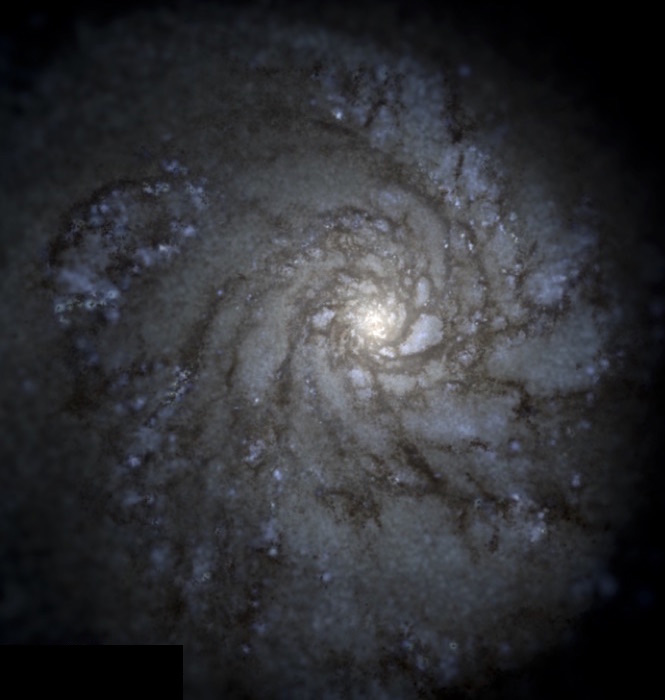There are some 50 or so satellite galaxies around the Milky Way, the most famous of which are the Magellanic Clouds. Somewhat incredibly, half of these have been discovered within the last 2 years, since they are small, faint, and have low surface brightness. The image below shows only the well known ‘classical’ satellites. The satellites are categorized primarily as dwarf spheroidals, and most are low in gas content.

Image credit: Wikipedia, Richard Powell, Creative Commons Attribution-Share Alike 2.5 Generic
“Satellite galaxies that orbit from 1,000 ly (310 pc) of the edge of the disc of the Milky Way Galaxy to the edge of the dark matter halo of the Milky Way at 980×103 ly (300 kpc) from the center of the galaxy, are generally depleted in hydrogen gas compared to those that orbit more distantly. The reason is the dense hot gas halo of the Milky Way, which strips cold gas from the satellites. Satellites beyond that region still retain copious quantities of gas.” – Wikipedia article
In a recent paper “The tangential velocity excess of the Milky Way satellites“, Marius Cautun and Carlos Frenk find that a sample of satellites (drawn from those known for more than a few years) deviates from the predictions of the canonical Λ – Cold Dark Matter (ΛCDM) cosmology. (Λ refers to the cosmological constant, or dark energy).
“We estimate the systemic orbital kinematics of the Milky Way classical satellites and compare them with predictions from the Λ cold dark matter (ΛCDM) model derived from a semi-analytical galaxy formation model applied to high resolution cosmological N-body simulations. We find that the Galactic satellite system is atypical of ΛCDM systems. The subset of 10 Galactic satellites with proper motion measurements has a velocity anisotropy, β = −2.2 ± 0.4, that lies in the 2.9% tail of the ΛCDM distribution. Individually, the Milky Way satellites have radial velocities that are lower than expected for their proper motions, with 9 out of the 10 having at most 20% of their orbital kinetic energy invested in radial motion. Such extreme values are expected in only 1.5% of ΛCDM satellites systems. This tangential motion excess is unrelated to the existence of a Galactic ‘disc of satellites’. We present theoretical predictions for larger satellite samples that may become available as more proper motion measurements are obtained.”
Radial velocities are easy, we get those from redshifts. Tangential velocities are much tougher, but can be obtained from relatively nearby objects by measuring their proper motions. That is, how much do their apparent positions change on the sky after many years have passed. It’s all the more tough when your object is not a point object, but a fuzzy galaxy!
For a ‘random’ distribution of velocities in accordance with ΛCDM cosmology, one would expect the two components of tangential velocity to be each roughly equal on average to the radial component, and thus 2/3 of the kinetic energy would be tangential and 1/3 would be radial. But rather than 33% of the kinetic energy being in radial motion, they find that the Galactic satellites have only about 1/2 that amount in radial, and over 80% of their kinetic energy in tangential motion.
Formally, they find a negative velocity anistropy, β, which as it is defined in practice, should be around zero for a ΛCDM distribution. They find that β differs from zero by 5 standard deviations.
One possible explanation is that the dwarf galaxies are mainly at their perigee or apogee points of their orbits. But why should this be the case? Another explanation: “alternatively indicate that the Galactic satellites have orbits that are, on average, closer to circular than is typical in ΛCDM. This would mean that MW halo mass estimates based on satellite orbits (e.g. Barber et al. 2014) are biased low.” Perhaps the Milky Way halo mass estimate is too low. Or, they also posit, without elaborating, do the excess tangential motions “indicate new physics in the dark sector”?
So one speculation is that the tangential motions are reflective of emergent gravity class of theories, for which dark matter is not required, but for which the gravitational force changes (strengthens) at low accelerations, of order , where H is the Hubble parameter, and the value works out to be around 2 centimeters per second per year. And it does this in a way that ‘spoofs’ the existence and gravitational affect of dark matter. This is also what is argued for in Modified Newtonian Dynamics, which is an empirical observation about galaxy light curves.
In the next article of this series we will look at Erik Verlinde’s emergent gravity proposal, which he has just enhanced, and will attempt to explain it as best we can. If you want to prepare yourself for this challenging adventure, first read his 2011 paper, “On the Origin of Gravity and the Laws of Newton”.

